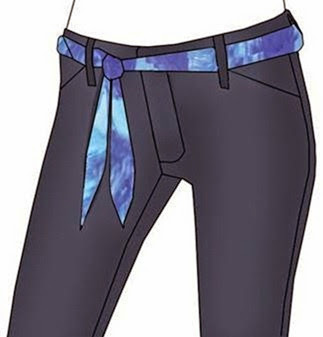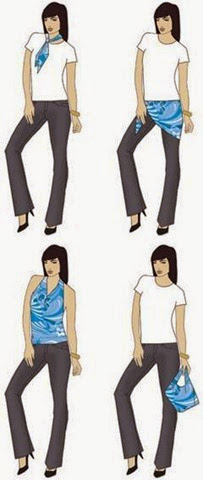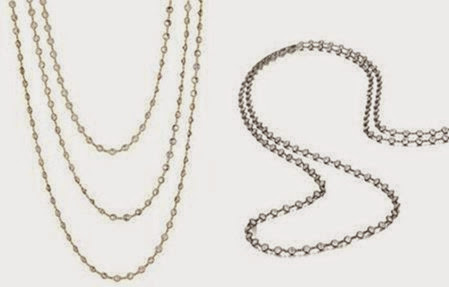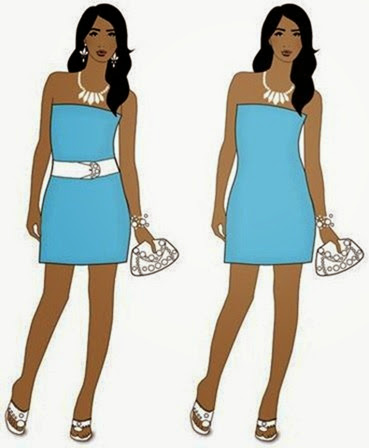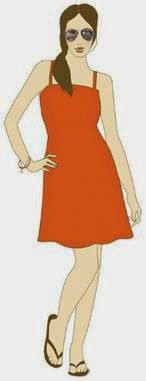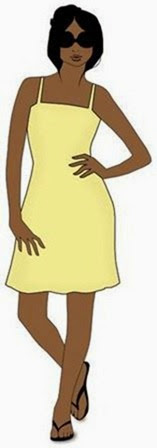Accessories
In This Chapter
▶ Expanding your wardrobe with statement pieces
▶ Incorporating jewelry into your style
▶ Updating your look with scarves
▶ Choosing the right bag
I have this fabulous pair of gold earrings (see the back cover picture). Without fail, every time I wear them, somebody stops me. The earrings cost under a hundred dollars, and I definitely got my money’s worth. I wear them with jeans and a T-shirt or a simple black dress. But no matter what I wear them with, they’re always a showstopper. Everyone needs a few accessories like that — pieces that can take an outfit from good to great.
This chapter shows you how to use accessories to take your wardrobe from simple to sizzling in a flash.
Scarves and Shawls
Unless you’re a big celebrity or have an unlimited bank account, it’s unlikely that you have a big enough ward- robe to wear a new outfit everyday (would be nice, right?).
You can make your outfits look different every time you wear them, though. It’s all about one word — accessories.
Here’s an item you probably have in the back of your closet: a printed scarf. Scarves have the power to expand your wardrobe by making each outfit look different, especially if you tend to wear monochromatic tops. Because the focus of the outfit is the scarf, no one will notice that you’re wearing the same white top you wore last week. Solid scarves can also make an outfit pop. If you wear a multi-colored top, you can add a solid-colored scarf for a little extra flair.
Scarves, particularly ones made of silk, take up very little room and don’t require much care. (Unless you get them dirty, you rarely need to dry clean them.) What’s also great is that they’re available in all price ranges. You can get a great one for $20 or splurge on a designer scarf and spend hundreds. With a scarf, you can get away with spending a little less because the price doesn’t affect how the scarf fits you.
Winter scarves
Winter scarves are those you wear when you cozy up in front of the fire! Even though many of us are all bundled up in the winter, you can still look chic. Use your winter scarf to make a statement (see Figure 15-1). Here are some tips:
✓ Have a couple different scarves to match your winter coats. Because you may wear your winter scarves almost every day in cold weather, go with solids or classic weaves like plaid, houndstooth, or herringbone.
✓ Feel your winter scarves before buying. Some wool can be scratchy. (If you’re buying online or through a catalogue, make sure to check the return policy.)
✓ If you can, choose natural fibers. Cashmere is a great option if you can afford to splurge on your scarf. Pashmina (a type of cashmere woven in Kashmir from goats that live high in the Himalayas) scarves are also very popular. Scarves made from man-made fibers generally aren’t as cozy and luxurious as those made from natural fibers.
Figure 15-1: Stay bundled up and still look chic.
Summer scarves
Ah, summertime! Now I know the last thing you want to do when it gets really nice out is bundle up, but you can wear scarves even when it’s warm to make an outfit complete. How? Use your scarf as an accessory to bring an outfit together. In the summer, I like to wear a white T-shirt with white jeans and tie a bright scarf around my neck. I also like to use my scarf as a belt, as in Figure 15-2. You probably didn’t realize your scarf had so many uses!
Figure 15-2: A new way to wear your favorite scarf.
Using a brooch to keep your scarf closed is another option. (I love using my grandmother’s old pins to make a statement.)
Tying a scarf: A quick how-to
Did you know your scarf can go from being a shirt to a purse in seconds? Turning a scarf into unexpected items is so much fun to do — always a show- stopper. Figure 15-3 shows the different ways to tie a scarf.
Figure 15-3: Different ways to use a scarf.
Around the neck
Tying a scarf around your neck is certainly the classic way to wear it, and it keeps you looking chic without making you too warm. Wearing a scarf like this can make an otherwise plain suit pop. If you wear one in the summer with a T-shirt, your outfit is more complete. Remember, when you wear a scarf this way, it’s part of your outfit and you’ll want to keep it on, even when you’re indoors.
To tie a scarf around your neck, as shown in Figure 15-3, follow these steps:
1. Fold the scarf into a triangle.
2. Starting with the point, fold inward until the scarf is one long line.
3. Tie it around your neck in either of the following ways:
• If the scarf is long: Start with it in the front of the neck and wrap it around the back and then back to the front. Tie a knot in the front.
• If the scarf is short: Place it around your neck and tie a knot in the front.
You can wear the knot either on the side or in the middle.
Around the waist
I love this look. Instead of using a conventional belt, try looping your scarf and threading it through the loops of your pants. This makes any outfit more fun (and is especially great with jeans). To turn a scarf into a belt (refer to Figure 15-2), follow these steps:
1. Fold the scarf into a triangle.
2. Starting with the point, fold inward until the scarf is one long line.
3. Put it through the loops of jeans or slacks and tie a knot in the front.
Or you can just tie it like a sarong over your jeans, as in Figure 15-3. Here’s how:
1. Fold scarf into a triangle.
2. Wrap around your waist and tie the two ends at one hip.
To tie a scarf like a halter top (see Figure 15-3), use a large square scarf (one that’s at least 36 inches square) and then follow these steps:
1. Place the scarf on a flat surface with the dull side facing up.
2. In the middle of the scarf, tie a tight small knot.
3. Take the two points directly across from each other and tie them around your neck.
4. Tie the remaining two corners around your waist and tie a knot around your back.
As a pocketbook
Yes! Another one of my favorites. Your scarf can be transformed into a pocketbook (refer to Figure 15-3). Use a 36-inch square scarf and follow these steps:
1. Place your scarf on a flat surface with the dull side facing up.
2. Take the two points diagonal from each other and tie a tight knot in the middle of the scarf.
3. Take the remaining two points and tie another knot (only 4 inches from the top). This becomes the handle of your new, fabulous pocketbook.
Jewelry
Your jewelry collection comprises the most personal and special pieces you own. You collect it over a lifetime, and you generally don’t replace those items every season or even every few years. Often you get jewelry as a gift for special occasions or you inherit pieces from your mother or grandmother. Whether they’re pieces you were given or bought yourself, real or fake, fine or costume, all can have sentimental value and make you feel special when you wear them. Knowing how to incorporate these pieces into your wardrobe is important because they can really express your personality and style.
Fine jewelry
Knowing what to splurge on and what to save on is really important. You shouldn’t spend a lot on some things (like trendy tops). Other items, though, are worth investing in. Two pieces are a must in every jewelry chest: diamond stud earrings and a pearl necklace.
If you don’t have the money right now to buy major jewelry pieces for your wardrobe, don’t feel that these pieces are a must right now. I just want you to know what pieces to concentrate on when and if the occasion arises when you can spend money on jewelry.
You don’t need to splurge on certain items. I wear faux jewelry all the time.
I bought the necklace in Figure 15-4 at my favorite store, Jennifer Miller (www. jennifermillerjewelry.com). The one on the left is real and costs thou- sands of dollars. The one on the right (which is mine) costs under $100. Crazy, right? (No way can you tell the difference!) Getting the same look as expensive jewelry without breaking the bank is possible.
©Jennifer Miller
Figure 15-4: Real diamonds (left) versus fake diamonds (right).
Birthstones
Although the idea of certain stones being associated with certain months dates back to the Old Testament, it wasn’t until the 18th century in Poland that the concept really took hold. Twelve birthstones exist, one for each month, and the list goes like this:
January — Garnet (deep red)
February — Amethyst (purple)
March — Aquamarine (pale blue)
April — Diamond (clear)
May — Emerald (green)
June — Pearl (white)
July — Ruby (red)
August — Peridot (pale green)
September — Sapphire (deep blue)
October — Opal (muilti-color)
November — Yellow Topaz (yellow)
December — Topaz (blue)
Some people become very attached to their birthstone and it becomes their signature stone. (Mine is diamond, so I am very attached!) If that’s the case with you, then incorporate your birthstone into your style and your wardrobe choices. If you were born in May, for example, emerald earrings or a necklace can make a black dress or suit pop instantly.
Diamond studs earrings
If you can afford to buy a set of diamond studs in platinum or white or yellow gold, go for it. They’ll last forever and will go with everything. I wear mine with everything from cocktail dresses to jeans and a T-shirt. Everyone, from surfer chicks to those who prefer classic attire, should have diamond studs. (They also come in clip-on.)
If you’re laughing because buying expensive jewels isn’t even an option right now, cubic zirconia studs are a great alternative. As long as you don’t go too big, it’s very hard (unless you’re a jeweler) to tell that they’re not real. Again, smaller studs — under 2 karats — look more believable yet significant. I wear faux diamonds when I’m on vacation and no one can tell.
A pearl necklace
Another staple that goes with many different outfits and takes you to many different occasions is a pearl necklace. Even if you prefer very casual dress, a strand of pearls will be useful for those times when you need to get dressed up. I wear pearls that my mother gave me, but if you don’t have a pearl neck- lace, you can purchase your own without emptying your wallet. Pearls come in many levels of quality — the more perfect they are, the more expensive. You don’t need perfect pearls. You can find necklaces made of pearls that have slight imperfections or that aren’t all exactly the same size (another reason for the higher price).
Again, as with diamond studs and cubic zirconia, you can also buy a faux pearl necklace that no one will know is faux when paired with your fabulous outfit. And, if your look is a little more bohemian than classic, you can go with freshwater pearls. These are less expensive and have a different, more unusual look.
Costume or fashion jewelry
I love costume jewelry. I have people in my life (my dear friend Sandi and my mother) who have so much of it that they have a system of organization. Both use plastic bags (so they can see each piece) and organize the pieces by their general look. Every woman should explore the world of costume jewelry; you can make it work no matter what your style. A statement neck- lace, earrings, or ring can really make an otherwise simple outfit fabulous. My pearl necklace (on the front cover) is an example of how a piece of great jewelry can dress up jeans instantly.
Costume or fashion jewelry is made with materials that are much less expensive than fine jewelry. What looks like gold may be gold-plated (a thin layer of gold over another metal, most often copper or silver) or gold-filled (a thicker layer of gold laid over another metal, often brass). The designation gold-filled requires that the weight of the gold equal one-twentieth the weight of the entire piece. Eventually, the outer layer of gold is going to wear away, but how long that takes depends on the manufacturing process and how careful you are in protecting the piece.
Costume and fashion jewelry can vary in price depending on whether or not the piece has a designer name attached to it or whether the materials are rhinestones, cubic zirconia, or the more expensive semi-precious stones. Because it’s more affordable, costume jewelry also enables you to buy different pieces to go with certain outfits. When you’re looking for the perfect accessory for a specific outfit, costume jewelry is a great option. You can build an outfit around a great piece.
Making your bangles and beads work
Playing around with different ways to wear jewelry is fun. Stacking several bracelets or necklaces can work, especially if you’re wearing a very simple outfit. Just remember: Wear only one statement piece at a time. If you opt for a ton of bangles on your arm, go with a more subtle necklace or earrings (studs always work).
Mixing real and faux jewelry is also a good idea because the real items make your costume jewels look that much richer.
Again, be careful of how much jewelry you wear at any given moment. One piece that pops is often the way to go. A great trick to guard against over- accessorizing is to put on everything you think you want to wear while your back is to the mirror, and then quickly turn around. The first thing you see in the mirror is the one thing that may be putting your outfit over the top. If you remove that item, you’re good to go. Figure 15-5 shows how too many accessories can overwhelm an outfit, but just the right number can make a great outfit even better.
Vintage jewelry
Although people don’t like the idea of wearing clothes that other people have worn, many women have a different feeling about vintage jewelry. Especially with formalwear, vintage is very popular and can give you a beautifully classic look.
Vintage jewelry can be anything from a brooch you pick up at a flea market to an engagement ring you buy at an expensive antique jewelry shop. Because it’s really about the look you’re going for, hunting for inexpensive and unusual pieces to spruce up your wardrobe is a great idea (and can be a fun project). As with costume jewelry, or any jewelry for that matter, you want certain pieces to pop, so don’t overdo it when you wear vintage jewelry. Try wearing one piece at a time and make that the focal point of your outfit. No one will be able to tell if it’s real or not, and you will get a chance to show your personal flair.
Figure 15-5: How not to accessorize (left) and how to accessorize (right).
Hats
I have hair that needs to be blown out or I look like I stuck my head in a socket. Hats are often my best friends on the days I just can’t bring myself to blow out my hair for an hour.
That said, before you add a bunch of hats to your wardrobe, you definitely have to be comfortable with wearing them. Hats worn for warmth in winter are definitely easier to get away with than ones that are pure fashion statements. Hats certainly aren’t for everyone (some people just don’t look good in them), but if you learn what works for you, hats are another way to achieve a different look, not to mention save you from a bad hair day!
The following is a list of the basic hat types:
✓ Baseball cap: Baseball caps are sporty and look best with workout clothes or jeans and a T-shirt.
They are most commonly worn when outside watching a sporting event or concert or when running around doing errands on a bad hair day. They are not especially fashionable, but they can be cute on the weekend.
✓ Beret: The French beret is made of soft wool in a multitude of colors. You can personalize it by pushing the crown to one side or the other, wearing it at many different angles, or even adding a brooch or pin to it. Berets are great for keeping warm and making a fashion statement. They’re a perfect addition to your fall wardrobe when the temperatures start dropping. Use a beret to top off a cute sweater, jeans, boots, and a wrap; or wear one with your new fall coat. Because you can mold them however you like and wear them in a number of ways, decide where it looks best (tilted right or left, or pushed more forward or back) and is most comfortable for you.
✓ Cowboy hat: The traditional ones are great if you live in the West but hard to match with anything other than jeans. However, straw versions of these are very popular in the summertime. The straw ones look great with a sun dress or a bathing suit on the beach.
✓ Fedora: Fedoras were originally made of soft felt. Like cowboy hats, nowadays fedoras can even be found in straw. This is a very stylish-looking hat and is generally worn to add flair to an otherwise simple outfit (see Figure 15-6).
Figure 15-6: A hat can serve as the statement piece of an outfit.
✓ Sun hat: These are usually made of straw or light canvas and have a wide brim to protect your face and neck from the harmful effects of the sun. Sun hats are great for the beach or just being out on a sunny summer day and work with almost any summertime outfit.
Bags
The only thing you have to be careful of when you wear hats is looking too gimmicky. You don’t want to appear as if you’re in a costume. Choose a hat that’s in style and make sure your personality is one that can carry it off before you incorporate that look into your wardrobe. Hats can land you in the hands of the fashion police when not worn correctly. If you have thoughts that the hat you chose may look silly, it likely does. I often ask my co-writer Dana if a hat looks good on me or if it’s too much. This is a time when a friend’s opinion helps a great deal.
If you’re looking for a hat that’s hard to find, try a vintage shop. As with jewelry, they’re great places to find that one-of-a-kind piece.
You’d be surprised how big a fashion statement a bag can make. Just as hemlines go up and down according to the latest trend, bags get bigger and smaller accordingly.
Types of bags
A great bag can actually make an entire outfit. You could be wearing jeans and a plain white top, but if you carry a fabulous statement bag you can change your whole look. Handbags come in a variety of categories, including:
✓ Baguette: A long, thin bag named after the French bread. Fashionistas set the trend with these when Fendi came out with these “it” bags.
✓ Clutch: This size bag works with everything from jeans to formal wear.
The more dressed up you are, the less you’re supposed to carry. When you’re at your most elegant, the only bag to carry is a small clutch (in most cases without a handle). These small bags force you to be very selective about what you take with you. However, a clutch is also appropriate if you don’t have much to carry and are just running to meet a friend for lunch or a casual dinner.
✓ Duffle: A take-off on the bags carried by sailors, a duffle bag is a large, roundish bag with a zipper on the top that holds your entire life and then some. Often more useful and durable than fashionable, this bag is perfect to hold everything you may need for day-to-day running around with the kids!
✓ Evening bag: Evening bags are usually clutches and often small enough to fit in your hand or under one arm. The level of detailing further declares how dressy a bag is. Fancier evening bags have a lot of detailing — like beads, sequins, and metallic fabric — that make them stand out. Some evening bags have a thin strap, handy when you need your hands to carry a drink during the cocktail hour, and the strap can usually be tucked inside if you want it to be simply a clutch. Judith Leiber is known for her beautiful evening bags that are uniquely shaped to match a woman’s interests and personality. (I was once given an evening bag shaped like a bird.)
✓ Hobo: These soft, crescent-shaped bags with a long handle are meant to be worn over the shoulder. Hobo bags are very stylish and also practical because they can hold a ton of stuff. They’re unstructured and go with clothing that is more casual or flowing.
✓ Kelly bag: This rectangular bag with a metal clasp is the epitome of luxury (see Figure 15-7). In addition to the traditional look, some are made from exotic leathers
Figure 15-7: The Kelly bag.
like alligator or ostrich. The prices can go as high as $27,000; and that goes for vintage bags as well as new ones.
Grace Kelly made these bags famous in 1956 when she used one to hide her pregnancy from prying photographers.
✓ Messenger: Originally created to carry mail or messages, this type of bag is large and, when the strap is placed across the back and chest, leaves both hands free. Today, you see it carried by both men and women in most large urban areas.
✓ Satchel: The traditional satchel bag is very much like a messenger bag, but the name has also been attached to other smaller bags with shorter handles that can be carried in your hand.
✓ Shoulder: Any bag that has a strap long enough to go over your shoulder is a shoulder bag.
✓ Tote: A tote bag is a large bag with an open top that’s good for carrying everything from groceries to a weekend’s worth of bikinis (see Figure 15-8).
This list should also include the simple handbag, because most bags that are sold don’t actually fit into a particular category. The simple handbag is available in a wide variety of shapes and sizes, with an amazing assortment of pockets and flaps on the inside to help you to organize your life.
Those of you who juggle a million things every day are going to need a bag that’s functional and practical as well as cute!
Luxury bags
High-end designer bags are definitely a luxury item. They are beautiful and well made (it can take up to 20 hours to make a hand-crafted bag). However, most of them cost upward of $1,000, so having even one can be a stretch for most people.
If you want that designer bag for a special event but don’t want to spend designer prices, try www.bagborroworsteal.com. This site allows you to rent luxury bags by the week or the month at prices that start from $50 and go to $200 (depending on whether or not you’re a member and how long you keep it).
Picking a handbag
Just as you wouldn’t choose a pair of pants or any other item of clothing simply by the way it looks on the shelf, you shouldn’t choose a handbag that way, either. Here are things to consider when buying your next handbag:
✓ Consider what color and style you need. Handbags get paired with so many different outfits, so consider carefully what color and style you need. My advice:
• Cover the basics first. Get a neutral bag that goes with everything. If you already have that great black bag and you want to invest in a new bag, go for a different color. If you tend to wear mostly neutrals, a bag in a fun color can be a great accent piece.
• If you’re buying a bag to go with a specific outfit, wear some- thing similar to that outfit when you go shopping. This way you’ll know that you’re making a smart purchase that matches the outfit you plan to wear it with.
✓ Check to see that the bag balances your size. A bag shouldn’t over whelm you if you’re on the smaller side. Just like your clothing, you want your bag to look right proportionately and enhance your overall look.
✓ Determine whether it complements your basic body shape. If you’re more round-shaped, you want to offset that with a square-ish, structured bag. But if you’re very angular, a round-shaped bag (like a crescent- shaped Hobo) may be better for you.
✓ Compare the bag color to your shoe color. It always looks polished to have shoes and a bag that complement each other. Having said that, the days when bags and shoes have to match exactly are gone. Putting together an outfit in which all your accessories work together without being too matchy-matchy lets you express your personal style and look current at the same time.
For Eyes: Spectacles
Of course glasses are used for their obvious purpose — to correct your vision — but they can also work as a great accessory. It comes as no surprise that many designers have come out with their very own line of frames. As with clothing, trends come and go in the optical world. Investing in frames that best suit your face before splurging on ones that may be hot only this season is definitely the way to go.
Matching frames to face
Faces, just like bodies, come in general shapes. Your face can be oval, oblong, round, square, or triangular. Recognizing the shape of your face assists you in determining what type of frame suits you best.
✓ Oval: An oval face looks good in just about any type of frame (see Figure 15-9).
✓ Oblong: Oblong faces are much longer than they are wide. Frames that sit in the middle of your face break up that long line.
✓ Round: To deemphasize the roundness of your face, choose frames with more straight lines.
✓ Square: To deemphasize a square face, choose frames that are more rounded (see Figure 15-10). Glasses that are heavier on the top also give a lengthening effect.
✓ Triangular: Avoid large frames that make the upper portion of your face look bigger.
Also stay away from bright colors, because these also draw attention to the top half of your face.
Figure 15-9: Aviator glasses go well with an oval-shaped face.
Skin tone and hair color also play a role in deciding which frame colors are right for you. Your glasses are meant to flatter and enhance your face, not overwhelm it. If your skin is very pale and you wear very dark glasses, for example, the glasses will stand out so much that people won’t appreciate the rest of your face.
The length of your nose is another factor to consider. If you have a short nose, wear lighter glasses that sit high on your face to maximize the visible length; if you have a long nose, glasses with a double bridge (two bars) can make it seem a bit shorter. Large frames can balance a large nose, but small frames only accentuate the size.
Figure 15-10: A round frame pairs


